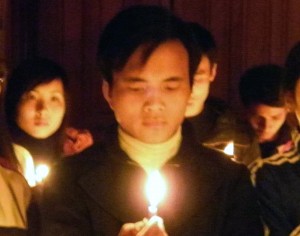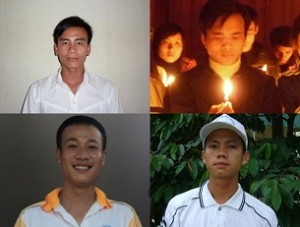By Pham Doan Trang and William Nguyen
The phrase “improper process and litigation procedures” is not enough to describe the trial of 29 Dong Tam residents that began in Hanoi this morning (September 7, 2020). The truth is much more horrific: this is a trial set up to normalize the silencing and murder of individuals.
At the opening of the trial, the court played a video for the lawyers and defendants…a “documentary report” on the wrongdoings of the Dong Tam residents (including the alleged murder of three police officers), as well as the tear-soaked words of friends and loved ones of these police officers.
The lawyers objected, asking that the court proceeds with hard evidence rather than a film, with its crew of producers, directors, and editors. The court, however, dismissed these concerns, telling the lawyers to simply “watch the film first.”
After the film was played and crimes against the accused announced, the terrifying reality of Vietnam’s police state was put on full and cruel display, judicial and executive branches merging into one.
All the defendants had confessional videos, prepared fully, carefully, and seamlessly by police. As each of the defendants’ names was read out, a clip of his or her confession was played.
However, each and every one of the defendants showed signs of torture or harassment so severe, they were unable to refuse “confessing.” One of the most severely beaten was Le Dinh Cong, Le Dinh Kinh’s son, who fully admitted guilt according to a prepared and meticulous script.
A number of “luckier” defendants were able to speak with their lawyers, revealing that they had been tortured until they could bear no more, that investigators pressured them to “just admit guilt now and retract it in court later”. But, in court, individuals who do just that are seen as stubborn and dishonest, their behavior is now seen as an aggravating circumstance. The court would also reject the defendant accusations of torture with a simple phrase: “No evidence.”
A number of others acquiesced to investigators after being told that “if you don’t admit guilt, you’re putting your family at risk…” The method is both fearsome and effective, for if some matter only involves an individual, then he or she can refuse to say anything, but if it involves loved ones, then he or she would do whatever it takes to protect them. The end result is a prisoners’ dilemma to out-“confess” one another, and ultimately, the entire house is arrested.
Elderly Bui Viet Hieu: Escaping death by “stray” bullet
Elder Bui Viet Hieu, born in 1943, a member of the Dong Tam Consensus, and seen by police as the second-most-important figure behind elder Le Dinh Kinh— is perhaps the most indomitable and tenacious defendant.
In the courtroom, he revealed chilling details: both he and Le Dinh Kinh were shot the night of January 9, when police attacked Dong Tam; but while Kinh was shot through the heart, Hieu’s bullet “strayed,” hitting his stomach and resulting in serious injury (rather than death). Police brought him to the hospital, where it was written in his file that the cause of injury was… inconclusive.
As soon as he recovered, Hieu was immediately incarcerated, and today, he appeared in court as one of the four “leading” defendants, the most serious of charges.
The court also presented the video as evidence of Hieu’s guilt, including a video of his forceful pronouncements against police. However, these clips showed evidence of being doctored, with Hieu confirming in the courtroom that these pronouncements were outdated, that they were recorded in 2017 during the “hostage crisis” in Dong Tam (when 38 police officers were held by residents in April 2017). The “filmmakers” at the Ministry of Public Security had combined these images with more recent ones.
Height Insoles: Hi, I do believe this is an excellent site. I stumbledupon …
http://fishinglovers.net: Appreciate you sharing, great post.Thanks Again. Keep writi…
Achilles Pain causes: Every weekend i used to pay a quick visit this site, as i w…






September 8, 2020
Murder by Trial
by Nhan Quyen • [Human Rights]
By Pham Doan Trang and William Nguyen
The phrase “improper process and litigation procedures” is not enough to describe the trial of 29 Dong Tam residents that began in Hanoi this morning (September 7, 2020). The truth is much more horrific: this is a trial set up to normalize the silencing and murder of individuals.
At the opening of the trial, the court played a video for the lawyers and defendants…a “documentary report” on the wrongdoings of the Dong Tam residents (including the alleged murder of three police officers), as well as the tear-soaked words of friends and loved ones of these police officers.
The lawyers objected, asking that the court proceeds with hard evidence rather than a film, with its crew of producers, directors, and editors. The court, however, dismissed these concerns, telling the lawyers to simply “watch the film first.”
After the film was played and crimes against the accused announced, the terrifying reality of Vietnam’s police state was put on full and cruel display, judicial and executive branches merging into one.
All the defendants had confessional videos, prepared fully, carefully, and seamlessly by police. As each of the defendants’ names was read out, a clip of his or her confession was played.
However, each and every one of the defendants showed signs of torture or harassment so severe, they were unable to refuse “confessing.” One of the most severely beaten was Le Dinh Cong, Le Dinh Kinh’s son, who fully admitted guilt according to a prepared and meticulous script.
A number of “luckier” defendants were able to speak with their lawyers, revealing that they had been tortured until they could bear no more, that investigators pressured them to “just admit guilt now and retract it in court later”. But, in court, individuals who do just that are seen as stubborn and dishonest, their behavior is now seen as an aggravating circumstance. The court would also reject the defendant accusations of torture with a simple phrase: “No evidence.”
A number of others acquiesced to investigators after being told that “if you don’t admit guilt, you’re putting your family at risk…” The method is both fearsome and effective, for if some matter only involves an individual, then he or she can refuse to say anything, but if it involves loved ones, then he or she would do whatever it takes to protect them. The end result is a prisoners’ dilemma to out-“confess” one another, and ultimately, the entire house is arrested.
Elderly Bui Viet Hieu: Escaping death by “stray” bullet
Elder Bui Viet Hieu, born in 1943, a member of the Dong Tam Consensus, and seen by police as the second-most-important figure behind elder Le Dinh Kinh— is perhaps the most indomitable and tenacious defendant.
In the courtroom, he revealed chilling details: both he and Le Dinh Kinh were shot the night of January 9, when police attacked Dong Tam; but while Kinh was shot through the heart, Hieu’s bullet “strayed,” hitting his stomach and resulting in serious injury (rather than death). Police brought him to the hospital, where it was written in his file that the cause of injury was… inconclusive.
As soon as he recovered, Hieu was immediately incarcerated, and today, he appeared in court as one of the four “leading” defendants, the most serious of charges.
The court also presented the video as evidence of Hieu’s guilt, including a video of his forceful pronouncements against police. However, these clips showed evidence of being doctored, with Hieu confirming in the courtroom that these pronouncements were outdated, that they were recorded in 2017 during the “hostage crisis” in Dong Tam (when 38 police officers were held by residents in April 2017). The “filmmakers” at the Ministry of Public Security had combined these images with more recent ones.